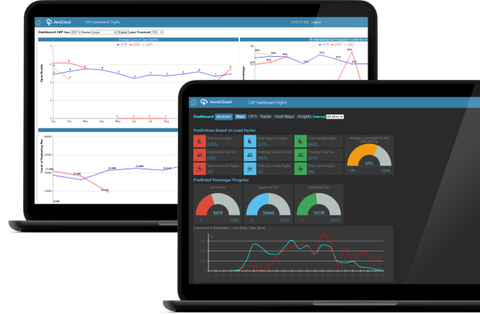Interview
AeroCloud CEO: legacy technology "isn’t fit for purpose"
Jasleen Mann speaks to George Richardson, CEO of AeroCloud, about the company’s strategy for disrupting the airport sector with its cloud-native.

George Richardson, AeroCloud CEO
Through its portfolio, Airport management software company AeroCloud strives to provide customers with a ‘crystal ball’, managing airports in real-time as well as predicting passenger flow and gate optimisation.
The company is developing a reputation for introducing new technologies, including artificial intelligence, machine learning, and cloud-native technology, as well as being ‘customer centric’ when offering solutions.
Here, Aerocloud CEO George Richardson discusses the journey the company has been on since its inception, the importance of democratising data in the airport industry, and modernising legacy operations.
Jasleen Mann: How was AeroCloud founded?
George Richardson: AeroCloud was founded in Macclesfield in the North West of England in 2019 by myself and my co-founder and our CTO, Ian Forde-Smith. He has worked in the airport sector his entire career, and I was a retired racing driver, having driven competitively for 10 years.
I was excited at the prospect of bringing together Ian’s extensive sector and technical knowledge and my commercial mindset to create solutions that enable the airport sector to seize on the benefits of the cloud.
We built a matchbox business plan designed to compete with and displace one of five legacy operators in the airport space. We’re a typical David and Goliath story and it’s been a tremendous journey since we first launched.
We’re forever grateful that our first customers at Northwest Florida Beaches International Airport and Tampa International Airport, who trusted in us. And, to our investors for taking the time to understand the airport technology sector and subsequently getting as excited as we are about the unforeseen potential we can bring to airports as a SaaS company.
Jasleen Mann: What are the company's key areas of focus?
George Richardson: AeroCloud is an intelligent management platform designed for the airport sector and the only cloud-native player in this space.
The platform enables everything from faster passenger processing times to improved self-service check-in and bag drop and facilitates, increased communication between stakeholders to deal with real-time fluctuations in processes to ensure that airports work better and communicate with their customers.
We recently also launched an industry-first computer vision solution for airports that offers kerb to gate insights for the first time.
AeroCloud Optic uses computer vision to intelligently, anonymously and accurately track passengers as they move through an airport. The real-time monitoring of passengers triggers alerts in response to operational bottlenecks such as extended wait times at security, which can then be immediately addressed.
The AI and machine learning algorithms also allow airport staff to identify trends and predict future scenarios to inform more accurate decision-making and long-term planning. This enables better resource management and enhanced retail opportunities for concession partners, which in turn improves the airport’s passenger experience.

AeroCloud Optic is a new software solution to track travellers as they move through an airport. Credit: Aerocloud
Jasleen Mann: What are the challenges you face in this area?
George Richardson: Airports are fast-moving complex domains, requiring smooth coordination of multiple factors in a high-pressure environment from security to passengers and airlines. A lack of synergy between these different factors can affect an airport’s performance – in some instances, operates at only around 66% capacity.
We want to solve problems that the aviation industry has struggled with for decades due to the reliance on on-site legacy technology, which isn’t fit for purpose because it’s clunky, needs on-site maintenance, and doesn’t take advantage of the latest technological innovations enabled through the cloud.
We have put in so much hard work to ensure that what we bring to the market is revolutionary for our sector, leveraging new technologies and practices to solve issues that have existed for decades.
We want to solve problems that the aviation industry has struggled with for decades.
We have also created an innovative ecosystem of evangelical customers, meaning we invite them to tell our product team their problems.
We then collaborate with them to find solutions, which informs the features that we create and deliver. This means that we remain customer-centric across every business area, from product design and development to customer support.
Our mission is to be the largest provider of airport operation automation software for the small to medium-sized airport market globally. In February 2023, we successfully raised $12.6m in Series A funding after we were able to demonstrate our commitment to and progress against this goal.
With this new funding, we plan to deliver on our bold ambitions to expand our business, employ local people in the North West where we were founded, and continue to displace our competitors.
Jasleen Mann: How important is the democratisation of data across airports?
George Richardson: Coordination and communication are key to operational management. Yet in many airports, most stakeholders are in the dark about the current state of play. Data is not readily accessible and many third parties might never see it beyond periodical reports.
Putting data in the hands of all relevant parties helps them understand how their services are performing and how that impacts the airport operations as a whole.
That is why we offer unlimited licenses to our cloud-based platform. We don’t want airports to have to choose who has access to data nor reduce its potential in supporting better operational decision-making.
Jasleen Mann: How does your strategy set you apart from your competitors?
George Richardson: The opportunity, we think, is a $20bn market in which legacy players dominate; AeroCloud is the only 100% cloud-native supplier, and we are shaking up the status quo.
We can centralise all an airport’s operational data and flight data in about 48 hours. Our data also operates in real-time and is up to 30% more accurate than our competitors. When airports require updates or issues fixed, we deliver these via the cloud, saving resourcing and money – unlike our legacy competitors who have to send a technician on site.
We also enable unlimited licenses per customer, so an airport’s entire stakeholder base can access the platform at no extra cost.
AeroCloud is the only 100% cloud-native supplier.
This means AeroCloud can be used on any device wherever an airport’s team is based, whether that’s onsite or remote, which ensures the platform is more secure than legacy systems which are often run on centrally located stack servers.
Even before the 2020 Covid-19 pandemic, which caused escalating passenger processing times and labour shortages, these issues were difficult to manage – particularly for small and medium-sized airports that don’t have the budgets and capacities that their larger peers do.
As travel returns to pre-pandemic levels, airports have struggled with adjusting to heightened demand, affecting operations worldwide.
And while it is still a difficult time for many airports due to the debts that arose during the pandemic, now is the time that they need to invest in improving operational efficiencies to help them boost passenger experience and revenue in the long term.